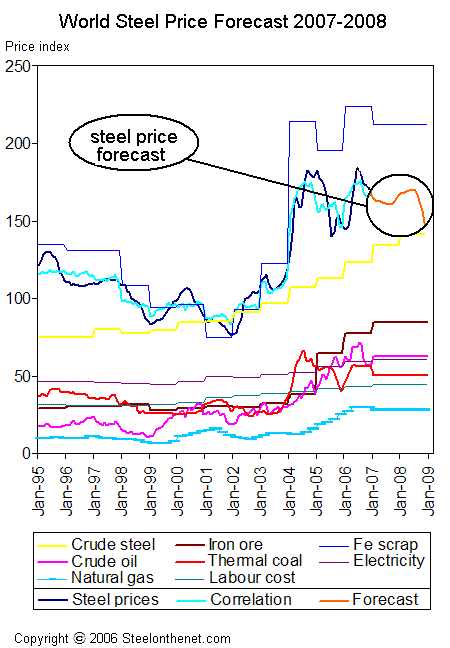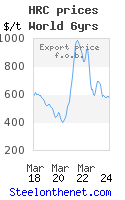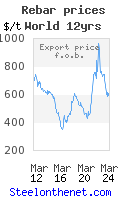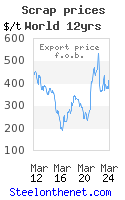Steel price forecast 2007-2008
As we reach the end of 2006, the consultants at www.steelonthenet.com thought it might be of interest to share our thoughts about world steel price evolution in 2007 and beyond.
The chart below summarises our thoughts. It shows historic world steel prices [indexed to Jan 2000 = 100] and the cost of most steelmaking input costs for the last twelve years, plus our price forecasts (circled).

The forecast is based on a mathematic analysis of the relationship between historic steel prices and each of the steelmaking cost inputs shown. Perhaps surprisingly, this analysis identifies only a weak (and insignificant) statistical relationship between steel prices and iron ore costs. A much stronger (and statistically significant) correlation proves evident between steel prices and (i) ferrous scrap and (ii) energy prices in the form of thermal coal, crude oil, and natural gas.
It may well be that scrap prices follow rather than lead steel prices, but industry experts see 2007 scrap prices either as largely unchanged from 2006 levels, or as falling.
Also, unlike iron ore (subject in recent days to a 9.5% price increase for 2007) most energy prices are forecast to fall in 2007. This applies especially to coal, where some experts predict 2007 price reductions of ~8 per cent, driven largely by improving infrastructure in Australia and higher output in Indonesia.
If we assume continued price cyclicality and recognise that the last peak of the price cycle was in mid-2006, this points us to the next pricing trough being around Q4 2007 and the next pricing peak being in Q3 2008.
Higher 2007 iron ore prices do not therefore mean higher 2007 steel prices. If historical fact is taken as a guide, falling energy prices and the inevitable down-swing of the 'normal' steel price cycle indicate falling steel prices and thus lower revenue streams for steelmakers in 2007.
For more information, contact economists@steelonthenet.com
The chart below summarises our thoughts. It shows historic world steel prices [indexed to Jan 2000 = 100] and the cost of most steelmaking input costs for the last twelve years, plus our price forecasts (circled).

The forecast is based on a mathematic analysis of the relationship between historic steel prices and each of the steelmaking cost inputs shown. Perhaps surprisingly, this analysis identifies only a weak (and insignificant) statistical relationship between steel prices and iron ore costs. A much stronger (and statistically significant) correlation proves evident between steel prices and (i) ferrous scrap and (ii) energy prices in the form of thermal coal, crude oil, and natural gas.
It may well be that scrap prices follow rather than lead steel prices, but industry experts see 2007 scrap prices either as largely unchanged from 2006 levels, or as falling.
Also, unlike iron ore (subject in recent days to a 9.5% price increase for 2007) most energy prices are forecast to fall in 2007. This applies especially to coal, where some experts predict 2007 price reductions of ~8 per cent, driven largely by improving infrastructure in Australia and higher output in Indonesia.
If we assume continued price cyclicality and recognise that the last peak of the price cycle was in mid-2006, this points us to the next pricing trough being around Q4 2007 and the next pricing peak being in Q3 2008.
Higher 2007 iron ore prices do not therefore mean higher 2007 steel prices. If historical fact is taken as a guide, falling energy prices and the inevitable down-swing of the 'normal' steel price cycle indicate falling steel prices and thus lower revenue streams for steelmakers in 2007.
For more information, contact economists@steelonthenet.com




2 Comments:
Good morning,
I have a couple of comments/questions indeed.
First of all, it strikes me that your raw material predictions in many cases are expected to be leveled at historical highs for the long run. But like in the case of iron ore, those prices more than cover marginal costs and a healthy charge for capital. Wouldn´t in the long run new entrants bring those prices down? How can the prices be sustained above those marginal costs in the long run?
You mentioned there is no correlation about iron ore prices and steel. It is clear that iron ore is way less volatile due to a much higher concentration. But what if iron ore prices are modeled to lag say 1 year behind steel prices do we still find no correlation?
Happy new year from Berlin!
Regards,
Joaquim Cortes
If you look at the light blue line at the top of the graph ('correlation') and compare it with the solid black line ('steel prices') you will see a very good correlation between actual and predicted prices, even over the short term. So we are talking about short and medium rather than just long term prices.
Second, as regards new entrants bringing prices down in the long run - please remember this is a high fixed cost business. New entrants do not simply come and go. In fact, the lack of exit is a major industry problem at times of overcapacity. This is what is so good about the current consolidation, as driven by Mittal Steel. At long last, steel shareholders might see a profit, as steel fights back against auto etc.
I have't done the lag. I guess that there are many, many permutations possible here. There is actually a weak correlation with iron ore prices - but it is only small. The maths is simply telling us that the correlations prefer other independent variables like crude oil or natural gas, which not only move more often but also move with greater magnitude. But please don't get me wrong - correlation does not prove causality, as they say.
blogger@steelonthenet.com
Post a Comment
<< Home